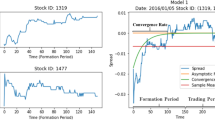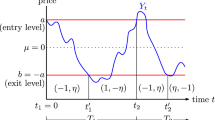Abstract
This work aimed to solve the problem of Markowitz portfolio optimization for a long-term horizon investment, through the pairs trading cointegrated strategy. Such a strategy allowed us to identify the prices and returns of each stock on the basis of a cointegration relationship estimated by means of the Vector Error Correction Model (VECM). Once the returns had been established, the Markowitz allocation problem among the pairs was solved by minimizing the portfolio risk. We proposed to determine the optimal allocation for each stock as a linear combination of the allocation coefficients calculated for each pair and the cointegration coefficients estimated by means of the VECM model. The proposed strategy was applied to three pairs of real cointegrated stocks belonging to the European financial sector. The results obtained were compared with those from five methods, proposed in the scientific literature, by means of a bootstrap simulation experiment.





Similar content being viewed by others
References
Akaike, H. (1974). A new look at the statistical model identification. IEEE Transactions on Automatic Control, 19(6), 716–723.
Alexander, G. (1976). The derivation of efficient sets. Journal of Financial and Quantitative Analysis, 11(5), 817–830.
Box, G. E. P., Jenkins, G. M., & Reinsel, G. C. (1994). Time series analysis: Forecasting and control. Englewood Cliff: Prentice Hall.
Bradley, M. D., & Jansen, D. W. (2004). Forecasting with a nonlinear dynamic model of stock returns and industrial production. International Journal of Forecasting, 20(2), 321–342.
Brandt, M. W., & Kang, Q. (2004). On the relationship between the conditional mean and volatility of stock returns: A latent VAR approach. Journal of Financial Economics, 72(2), 217–257.
Broussard, J. P., & Vaihekoski, M. (2012). Profitability of pairs trading strategy in an illiquid market with multiple share classes. Journal of International Financial Markets, Institutions and Money, 22(5), 1188–1201.
Burmeister, E., & McElroy, M. B. (1988). Joint estimation of factor sensitivities and risk premia for the arbitrage pricing theory. The Journal of Finance, 43(3), 721–733.
Byrne, B., & Lee, S. (2004). Different risk measures: Different portfolio compositions? Journal of Property Investment & Finance, 22(6), 501–511.
Caldeira, J. F., & Moura, G. V. (2013). Selection of a portfolio of pairs based on cointegration: A statistical arbitrage strategy. Review Brazilian Finance, 11(1), 49–80. as (Online), Rio de Janeiro,
Calvo, C., Ivorra, C., & Liern, V. (2012). On the computation of the efficient frontier of the portfolio selection problem. Journal of Applied Mathematics, 2012(105616), 1–25.
Campbell, J. Y. (1987). Stock returns and the term structure. Journal of Financial Economics, 18(2), 373–399.
Campbell, J. Y., Grossman, S. J., & Wang, J. (1993). Trading volume and serial correlation in stock returns. The Quarterly Journal of Economics, 108(4), 905–939.
Campbell, R., Huisman, R., & Koedijk, K. (2001). Optimal portfolio selection in a value-at-risk framework. Journal of Banking and Finance, 25(9), 1789–1804.
Campbell, J. Y., & Viceira, L. M. (1999). Consumption and portfolio decisions when expected returns are time varying. The Quarterly Journal of Economics, 114(2), 433–492.
Campbell, J. Y., & Viceira, L. M. (2001). Strategic assets allocation : Portfolio choice for long-term investors, Clarendon lectures in economics (p. 272). Oxford: Oxford University Press.
Casella, R. L. (2002). Statistical inference (p. 660). Pacific Grove: Duxbury Advanced Series.
Chen, N.-F., Roll, R., & Ross, S. A. (1986). Economic forces and stock market. The Journal of Business, 59(3), 383–403.
Chiu, M. C., & Wong, H. Y. (2011). Mean-variance portfolio selection of cointegrated assets. Journal of Economic Dynamics and Control, 35(8), 1369–1385.
Chiu, M. C., & Wong, H. Y. (2018). Robust dynamic pairs trading with cointegration. Operation Research Letters, 46(2), 225–232.
Chung, P. J., & Liu, D. J. (1994). Common stochastic trends in Pacific Rim stock markets. The Quarterly Review of Economics and Finance, 34(3), 241–259.
Connor, G. (1995). The three types of factor models: a comparison of their explanatory power. Financial Analysts Journal, 51(3), 42–46.
Efron, B. (1979). Bootstrap methods: another look at the jackknife. Annals of Statistics, 7(1), 1–26.
Elliot, R. J., Van Der Hoek, J., & Malcolm, W. P. (2007). Pairs trading. Quantitative Finance, 5(3), 271–276.
Elton, E., Gruber, M., & Rentzler, J. (1983). The arbitrage pricing model and returns on assets under uncertain inflation. The Journal of Finance, 38(2), 525–537.
Engle, R. F., & Granger, C. W. J. (1987). Co-integration and error correction: representation, estimation and testing. Econometrica, 55(2), 258–276.
Fama, E. F. (1998). Determining the number of priced state variables in the ICAPM. Journal of Financial and Quantitative Analysis, 33(2), 217–231.
Fama, E. F., & French, K. R. (1993). Common risk factors in the returns on stocks and bonds. Journal of Financial Economics, 33(3), 3–56.
Gârleanu, N., & Pedersen, L. H. (2013). Dynamic trading with predictable returns and transaction costs. The Journal of Finance, 68(6), 2309–2340.
Gasser, S. M., Rammerstorfer, M., & Weinmayer, K. (2017). Markowitz revised: social portfolio engineering. European Journal of Operation Research, 258(3), 1181–1190.
Gatev, E., Goetzmann, W. N., & Rouwenhorst, G. (2006). Pairs trading: performance of a relative-value arbitrage rule. The Review of Financial Studies, 19(3), 797–827.
Green, R. C. (1986). Positively weighted portfolio on the minimum-variance frontier. The Journal of Finance, 41(5), 1051–1068.
Griffin, J. M. (2002). Are the Fama and French factors global or country specific? Review of Financial Studies, 15(3), 783–803.
Harvey, A. C. (1989). Forecasting, structural time series models and the Kalman Filter (p. 572). Cambridge: Cambridge University Press.
Hasuike, T., Katagiri, H., & Ishii, H. (2009). Portfolio selection problems with random fuzzy variable returns. Fuzzy Sets and Systems, 160(18), 2579–2596.
Huang, X. (2007). Portfolio selection with fuzzy returns. Journal of Intelligent and Fuzzy Systems, 18(4), 383–390.
Johansen, S. (1991). Estimation and hypothesis testing of cointegration vectors in Gaussian vector autoregressive models. Econometrica, 59(6), 1551–1580.
Johansen, S. (1995). Likelihood-based inference in cointegrated vector autoregressive models. Oxford: Oxford University Press.
Leung, P.-L., Ng, H.-Y., & Wong, W.-K. (2012). An improved estimation to make Markowitz’s portfolio optimization theory users friendly and estimation accurate with application on the US stock market investment. European Journal of Operational Research, 222(1), 85–95.
Levy, H. (1973). The demand for assets under conditions of risk. The Journal of Finance, 28(1), 79–96.
Luenberger, D. G. (1998). Investment science (p. 494). New York: Oxford University Press.
Lütkepohl, H. (2005). New introduction to multiple time series analysis. Berlin: Springer.
Mangram, M. E. (2013). A simplified perspective of the Markowitz portfolio theory. Global Journal of Business Research, 7(1), 59–70.
Markowitz, H. M. (1952). Portfolio selection. The Journal of Finance, 7(1), 77–91.
McCausland, W. J., Miller, S., & Pelletier, D. (2011). Simulation smoothing for state-space models: A computational efficiency analysis. Computational Statistics and Data Analysis, 55(1), 199–212.
Mukherjee, T. K., & Naka, A. (1995). Dynamic relations between macroeconomic variables and the Japanese stock market: An application of a vector error correction model. The Journal of Financial Research, 18(2), 223–237.
Naccarato, A., & Pierini, A. (2014). BEKK element-by-element estimation of a volatility matrix. A portfolio simulation. In P. Cira & S. Marilena (Eds.), Mathematical and statistical methods for actuarial sciences and finance (pp. 145–148). Cham: Springer.
Perlin, M. S. (2009). Evaluation of pairs-trading strategy at the Brazilian financial market. Journal of Derivatives and Hedge Funds, 15(2), 122–136.
Pla-Santamaria, D., & Bravo, M. (2013). Portfolio optimization based on downside risk: A mean-semivariance efficient frontier from Dow Jones blue chips. Annals of Operations Research, 205(1), 189–201.
Pole, A. (2007). Statistical arbitrage. Hoboken: Wiley.
Priestley, R. (1996). The arbitrage pricing theory, macroeconomic and financial factors, and expectations generating processes. Journal of Banking and Finance, 20(5), 869–890.
Salah, H. B., Chaouch, M., Gannoun, A., & De Peretti, C. (2018). Mean and median-based nonparametric estimation of returns in mean-downside risk portfolio frontier. Annals of Operations Research, 262(2), 653–681.
Sanei, M., Banihashemi, S., & Kaveh, M. (2016). Estimation of portfolio efficient frontier by different measures of risk via DEA. International Journal of Industrial Mathematics, 8(3), 10. Article ID IJIM-00460.
Sharpe, W. F. (1992). Asset allocation: Management style and performance measurement. Journal of Portfolio Management, 30(10), 7–16.
Sharpe, W. F. (1994). The Sharpe Ratio. Journal of Portfolio Management, 21(1), 49–58.
Soleimani, H., Golmakani, H. R., & Salimi, M. H. (2009). Markowitz-based portfolio selection with minimum transaction lots, cardinality constraints and regarding sector capitalization using genetic algorithm. Expert Systems with Applications, 36(3), 5058–5063.
Tsay, R. S. (2010). Analysis of financial time series (p. 720). Hoboken: Wiley.
Vidyamurthy, G. (2004). Pairs trading: quantitative methods and analysis. Hoboken: Wiley.
Zhao, Z., & Palomar, D. P. (2018). Mean-reverting portfolio with budget constraint. IEEE Transactions on Signal Processing, 66(9), 2342–2357.
Zopounidis, C., Doumpos, M., & Fabozzi, F. J. (2014). Preface to the special issue: 60 years following Harry Markowitz’s contributions in portfolio theory and operations research. European Journal of Operational Research, 234(2), 343–345.
Acknowledgements
Authors would like to thank the anonymous referees for their careful reviews of this paper.
Author information
Authors and Affiliations
Corresponding author
Additional information
Publisher's Note
Springer Nature remains neutral with regard to jurisdictional claims in published maps and institutional affiliations.
Rights and permissions
About this article
Cite this article
Naccarato, A., Pierini, A. & Ferraro, G. Markowitz portfolio optimization through pairs trading cointegrated strategy in long-term investment. Ann Oper Res 299, 81–99 (2021). https://doi.org/10.1007/s10479-019-03225-y
Published:
Issue Date:
DOI: https://doi.org/10.1007/s10479-019-03225-y




